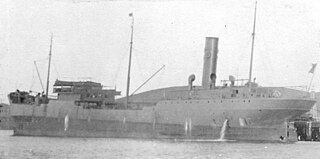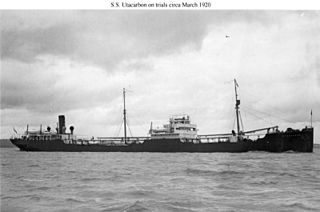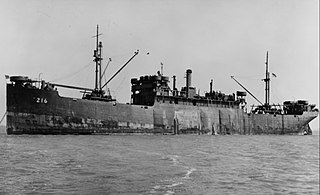
The second USS Abarenda (IX-131) was a storage tanker, one of many miscellaneous-class Navy vessel crewed by the United States Coast Guard during World War II.
USS Arethusa (IX-135) began life as Gargoyle—a tanker built in 1921 at Oakland, Calif., by the Moore Shipbuilding Co. and was renamed Arethusa by the Navy and designated IX-135 on 3 November 1943; acquired by the Navy on 23 March 1944 from the War Shipping Administration on a bareboat basis for use as a mobile floating storage tanker; and placed in commission on that same day at Majuro Atoll, Marshall Islands.

USS Alameda, was a United States Navy tanker in commission from 1919 to 1922. She was built as the civilian tanker SS Alameda, but transferred to the U.S. Navy after completion in 1919. She was sold for commercial service and operated under the names SS Olean and SS Sweep before she was transferred to the Navy again in World War II as USS Silver Cloud (IX-143).

USS Leopard (IX-122), an Armadillo-class tanker designated an unclassified miscellaneous vessel, was a United States Navy ship named for the leopard, a large and ferocious spotted cat of southern Asia and Africa. Her keel was laid down as William B. Bankhead on 5 October 1943 by Delta Shipbuilding Company, in New Orleans, Louisiana, under a Maritime Commission contract. She was renamed Leopard on 27 October 1943, launched on 15 November 1943 sponsored by Mrs. William B. Bankhead, acquired by the Navy 24 December 1943, and commissioned on 26 December 1943.
USS Moose (IX-124), an Armadillo-class tanker designated an unclassified miscellaneous vessel, was the second ship of the United States Navy to be named for the moose, a large ruminant animal of the deer family, found in Canada and the northern United States. Originally named Mason L. Weems, she was renamed Moose 27 October 1943. Her keel was laid down on 1 November 1943 by Delta Shipbuilding Company in New Orleans, Louisiana. She was launched on 17 December 1943 sponsored by Mrs. Douglas E. Schultheiss, acquired by the Navy on a bareboat charter from the War Shipping Administration on 27 January 1944, and commissioned on 28 January 1944.
USS Domino (IX-208), an unclassified miscellaneous vessel, was the only ship of the United States Navy to be named for the game piece. The freighter was acquired from the War Shipping Administration in May 1945. The hull classification symbol IX-208 was reserved for her, but she was never taken up on the list of naval vessels, and no classification was ever assigned to her. She was returned to the War Shipping Administration (WSA) in February 1946.
USS Flambeau (IX-192), was the tanker S. B. Hunt, built for Standard Oil Company of New Jersey. Her keel was laid down in 1919 by Sun Shipbuilding and Drydock Company, in Chester, Pennsylvania with completion August 1919.
USS Chotauk (IX-188), an unclassified miscellaneous vessel, was the victim of a typographical error: she was intended to be named for USS Chotank. Her keel was laid down in 1920 by Bethlehem Shipbuilding Corporation's Fore River Shipyard in Quincy, Massachusetts, as Japan Arrow (later renamed American Arrow), transferred from the War Shipping Administration at Pearl Harbor on 29 November 1944, and commissioned the same day.

USS Gardoqui (IX-218), an unclassified miscellaneous vessel, was the only ship of the United States Navy to be named for USS Gardoqui, a Spanish gunboat captured during the Spanish–American War. Her name was misspelled when she was christened. Gardoqui was named for the commercial house of Joseph Gardoqui and Sons of Bilbao, Spain, which represented the American Colonies in the Spanish court during the American Revolution. Her keel was laid down in 1921 by the Federal Shipbuilding Company, in Kearny, New Jersey. She was acquired from the War Shipping Administration and commissioned at Pearl Harbor on 23 June 1945 with Lieutenant Harold L. Tysinger in command.
USS Nausett (IX–190) was a tanker serving as an auxiliary ship in the United States Navy during World War II. Built as W. M. Irish the ship was a commercial tanker until taken by the War Shipping Administration (WSA) during World War II. WSA first allocated the ship to the Army and then as lend lease to the Soviet Union where the ship was renamed Moskva. On return the ship was renamed Nausett and allocated to the Navy which first accepted the vessel and then found it too expensive to make suitable. The ship was returned to WSA, placed in reserve and sold for scrap the next year.
The USS Arayat (IX-134) was a petroleum tanker built in 1918 at Glasgow, Scotland, by Fairfield Shipbuilding, as SS Faireno. She was acquired by the United States Navy from the War Shipping Administration on 13 April 1944 at Brisbane, Australia, and commissioned there on 18 April 1944.

USS Majaba (AG-43/IX-102) was the Design 1049 cargo ship Meriden built in 1919 by the Albina Engine & Machine Works, Portland, Oregon. All the ships were requisitioned by the United States Shipping Board (USSB) for World War I service. The ship was bought by the E. K. Wood Lumber Co., of San Francisco, California in 1923 and renamed El Capitan. The ship was chartered by the U.S. Navy through the War Shipping Administration (WSA) in April 1942 and commissioned as Majaba.

The second USS Yucca (IX-214) was a tanker that served in the United States Navy from 1945 to 1946.
The third USS Dawn (IX-186) was a United States Navy tanker in commission from 1944 to 1946.

USS Standard Arrow (ID-1532) was a United States Navy tanker in commission from 1917 to 1919. She was built as SS Standard Arrow for the Standard Oil Company. In World War II, she was again acquired by the U.S. Navy from Standard Oil and commissioned as USS Signal (IX-142) a station tanker in the Pacific from 1944 to 1946.

The T3 tanker, or T3, are a class of seaworthy large tanker ships produced in the United States and used to transport fuel oil, gasoline or diesel before and during World War II, the Korean War and the Vietnam War. The T3 tanker classification is still used today. The T3 tanker has a full load displacement of about 24,830 tons.

The second USS Marmora (IX-189) was a United States Navy tanker in commission from 1944 to 1946. She saw service as a mobile floating storage ship during and in the immediate aftermath of World War II.
USS Sea Foam (IX-210) was a Mobile Floating Storage Tanker of the United States Navy in the closing stages of World War II. Sea Foam was built as the SS Pennsylvania—an Emergency Fleet Corporation Design 1045 tanker in Quincy, Massachusetts, in 1917 for World War I civilian merchant service.

SS Unicoi was an American Design 1027 cargo ship built in 1920 for service in World War II. She was later acquired by the United States Navy and renamed USS Unicoi (IX-216). Her namesake is a county and a mountain range in Tennessee. The word unicoi is derived from the Cherokee term "unaka" which means white.










